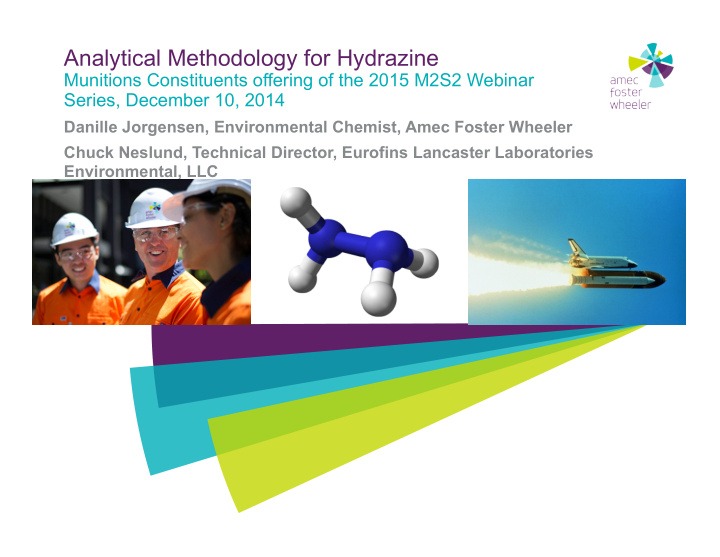



Analytical Methodology for Hydrazine Munitions Constituents offering of the 2015 M2S2 Webinar Series, December 10, 2014 Danille Jorgensen, Environmental Chemist, Amec Foster Wheeler Chuck Neslund, Technical Director, Eurofins Lancaster Laboratories Environmental, LLC
Analytical Methodology for Hydrazine Overview 1. Introduction 2. What are hydrazines? 3. Analytical Methods 4. Case Study
What are Hydrazines? Methyl Hydrazine Hydrazine (Monomethyl hydrazine) 1,1-Dimethyl Hydrazine (Unsymmetrical dimethyl hydrazine – UDMH) 3
What are Hydrazines? • Most commonly known for use as rocket fuels/propellants • Most currently used as a chemical blowing agent for polymer foams • 1,1-Dimethylhydrazine has been linked to the generation of NDMA 4
Analysis of Hydrazines Literature shows following approaches to analysis of hydrazines; • Colorimetric • LC (liquid chromatography) with RI (refractive index) and UV (ultraviolet) • GC (gas chromatography) with derivatization All methods suffer from high limits and varying specificity 5
ASTM 1385-07 Summary • Method that uses colorimetric determination for hydrazine • Applicable to aqueous samples (well water, condensates, boiler feed waters) • Calibrates only for hydrazine 6
ASTM 1385-07 Summary (cont’d) • Water samples to be pH adjusted immediately after sampling (1 ml HCl to 100 mls sample) • No specific holding time given • Samples derivatized with p-dimethylaminobenzaldehyde • Derivatized samples analyzed with a spectrophotemeter operated at 458 nm 7
ASTM 1385-07 Summary (cont’d) • Instrument calibrated with a 7 point curve up to 200 ug/l • Low point of curve (LOQ) = 5 ug/l • Specific QC not prescribed but precision and recovery data from multi-laboratory study presented • Interferences include oxidizing substances, colored water in the prescribed wavelength, turbidities and aromatic amines 8
What is ELLE’s Approach? LC/MS/MS • Greater Sensitivity • Better Specificity – reduce probability of any interferences • Only small volume required • Chromatographic separation allows for analysis of several hydrazines 9
What is ELLE’s Approach? Summary of Method • Developed in-house, using proprietary techniques • Hydrazines are derivatized using chemistry similar to formaldehyde (SW-846 8315) • Only small volume required for analysis - 1 ml for waters - 1 gram for soils 10
What is ELLE’s Approach? Summary of Method • LC/MS/MS with APCI (atmospheric pressure chemical ionization) • Limits - LOQs Water Soil Hydrazine 0.1 ug/l 2 ng/g MMH 0.5 ug/l 5 ng/g UDMH 0.5 ug/l 5 ng/g 11
What is ELLE’s Approach? Example Chromatogram (TIC and SRM) of Calibration Standard 12
What is ELLE’s Approach? Summary of Method • Full EPA QC run with analytical batch Method Blank LCS/LCSD MS/MSD • Method also adapted to extract and analyze soil samples (and other solid matrices) 13
Acknowledgement • Meng Yu (Eurofins Lancaster Laboratories Environmental) 14
Eurofins Environment Testing Contacts Charles J. Neslund Technical Director, Environmental Sciences Direct 717-556-7231 CharlesNeslund@eurofinsUS.com Jane D. Huber National Program Manager – Government Services Mobile 717-209-1438 JaneHuber@EurofinsUS.com David M. Velasquez Senior Account Manager Mobile: 510-872-2016 DavidVelasquez@eurofinsus.com 15
Analytical Methodology for Hydrazine Case Study-Project Background ► RFI to assess waste disposal and spills at two sites ► Base supports aerospace system development ► Development and evaluation of advanced aircraft, missiles, satellites, and space vehicles ► Includes air breathing engine and rocket propulsion system testing facilities. ► Site 1 – hydrazine off loading rack ► Used through 1993, hydrazine delivered by rail to off loading rack ► Transferred via underground piping to an above ground storage tank ► RFI conducted between May 2004 and Feb 2008 ► Detections of hydrazine in soil exceeded PRG of 0.57 mg/kg ► Detections of hydrazine in groundwater exceeded PRG of 0.022 µ g/ L 16
Analytical Methodology for Hydrazine Case Study - DQOs ► Site 1 Data Quality Objectives ► Nature and extent of COCs ► Close data gaps ► Complete characterization of two sites ► Risk Assessment 17
Analytical Methodology for Hydrazine Case Study - CSM Description COCs Migration Pathway Exposed Population Suspected hydrazine VOCs Infiltrate surface soil Site Workers, spill site Visitors, SVOCs Volatilization Trespassers, Suspected sources: Biota hydrazine off-loading Hydrazine Residual constituents rack and underground bound to soil material Via transfer lines transported into stormwater drain via Dermal, Overburden consist of erosion Accidental moderately-well drained ingestion, to poorly drained soil Leach through soil into Inhalation groundwater Located in an Industrial Area Movement within groundwater 18
Analytical Methodology for Hydrazine Case Study – The Problem ► 5 temporary MWs and 9 permanent MWs ► Hydrazine by D1385-7 (Jan 2013) ► Detections of 3 to 11 µ g/L ► Results do not agree with CSM ► MW locations are upgradient and cross-gradient of Former Hydrazine Rack 19
Analytical Methodology for Hydrazine Case Study – Evaluation of Methodology ► Analytical Methodology ► Hydrazine concentrations are in lower end or outside usable range of D1385-7 ► Recommendations to decrease measurement uncertainty for D1385-7 ► Switch to LC/MS/MS (ELLE 8315) ► Field Methodology ► Change hold time from collection to analysis to 7 days ► Acidify sample in the field ► Use of ferrous iron kit to identify potential interference 20
Analytical Methodology for Hydrazine Case Study – The Data MW01 MW02 MW03 MW04 MW05 MW06 MW07 MW08 MW09 MW10 MW11 Sample Date Method µ g/L D1385 1/13 2 3 <1.5 11 11 4 7 3 4 3 3 4/13 <0.050 <0.050 <0.050 <0.050 <0.050 <0.050 <0.050 <0.050 <0.050 <0.050 <0.050 ELLE 8315 10/13 <0.050 <0.050 <0.050 <0.050 <0.050 <0.050 <0.050 <0.050 <0.050 <0.050 <0.050 21
Analytical Methodology for Hydrazine Conclusions ► Eurofins Lancaster modified 8315 provided data that better achieved the project DQOs ► Reducing interferences (e.g. turbidity) ► Lower detection limits ► Field preservation ► Robust QC 22
Analytical Methodology for Hydrazine Thank You Danille Jorgensen Environmental Chemist Direct 425-368-0957 Danille.Jorgensen@amec.com Charles J. Neslund Technical Director, Environmental Sciences Direct 717-556-7231 CharlesNeslund@eurofinsUS.com 23
Recommend
More recommend